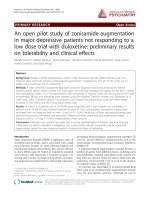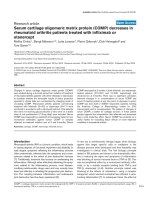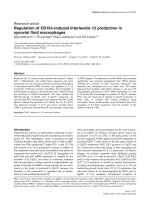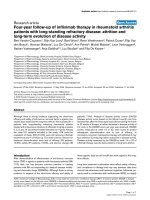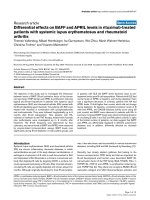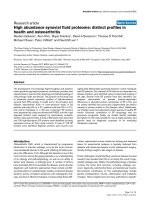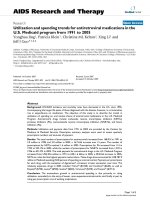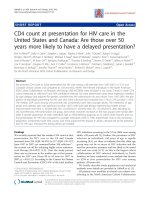Báo cáo y học: "Bench-to-bedside review: Preventive measures for contrast-induced nephropathy in critically ill patients" pps
Bạn đang xem bản rút gọn của tài liệu. Xem và tải ngay bản đầy đủ của tài liệu tại đây (78.24 KB, 10 trang )
361
CI = confidence interval; NAC = N-acetylcysteine; RR = relative risk.
Available online />Abstract
An increasing number of diagnostic imaging procedures requires
the use of intravenous radiographic contrast agents, which has led
to a parallel increase in the incidence of contrast-induced nephro-
pathy. Risk factors for development of contrast-induced nephro-
pathy include pre-existing renal dysfunction (especially diabetic
nephropathy and multiple myeloma-associated nephropathy),
dehydration, congestive heart failure and use of concurrent nephro-
toxic medication (including aminoglycosides and amphotericin B).
Because contrast-induced nephropathy accounts for a significant
increase in hospital-acquired renal failure, several strategies to
prevent contrast-induced nephropathy are currently advocated,
including use of alternative imaging techniques (for which contrast
media are not needed), use of (the lowest possible amount of) iso-
osmolar or low-osmolar contrast agents (instead of high-osmolar
contrast agents), hyperhydration and forced diuresis. Admini-
stration of N-acetylcysteine, theophylline, or fenoldopam, sodium
bicarbonate infusion, and periprocedural haemofiltration/haemo-
dialysis have been investigated as preventive measures in recent
years. This review addresses the literature on these newer strategies.
Since only one (nonrandomized) study has been performed in
intensive care unit patients, at present it is difficult to draw firm
conclusions about preventive measures for contrast-induced
nephropathy in the critically ill. Further studies are needed to
determine the true role of these preventive measures in this group
of patients who are at risk for contrast-induced nephropathy.
Based on the available evidence, we advise administration of N-
acetylcysteine, preferentially orally, or theophylline intravenously,
next to hydration with bicarbonate solutions.
Introduction
Contrast-induced nephropathy, defined as an increase in
serum creatinine by more than 25% or 44 µmol/l from
baseline within 3 days after administration of contrast agents
in the absence of an alternative aetiology [1,2], is a major
cause of hospital-acquired acute renal failure [3,4]. Indeed,
the incidence of contrast-induced nephropathy is as high as
10–30% in high-risk patient groups [5–8]. Contrast-induced
nephropathy increases morbidity, mortality and costs of
medical care, and length of hospital stay, and not just for
those patients who need renal replacement therapy because
of this complication [3,5,7–9]. Risk factors for contrast-
induced nephropathy include pre-existing renal failure
(especially diabetic nephropathy and multiple myeloma),
hypovolaemia, administration of (cumulative) high doses of
(hyperosmolar) contrast media, and concomitant use of drugs
that interfere with the regulation of renal perfusion [3,8,
10–13].
The Contrast Media Safety Committee of the European
Society of Urogenital Radiology [14] has produced simple
guidelines to prevent contrast-induced nephropathy. These
guidelines emphasize the importance of patient selection
(avoid the use of contrast media in high risk groups; i.e. use
another imaging technique) and advises avoidance of the use
(of large doses) of (hyperosmolar) contrast agents. Furthermore,
the guidelines recommend ensuring that patients are well
hydrated; cessation of diuretics (particularly loop-diuretics);
and cessation of concurrent nephrotoxic drugs, such as non-
steroidal anti-inflammatory drugs, aminoglycosides, amfotericine
B, and antiviral drugs like acyclovir and foscarnet.
Critically ill patients are a group at high risk for the
development of contrast-induced nephropathy because they
frequently suffer from renal failure as a part of multiple organ
failure, and they may have pre-existing diabetic nephropathy.
Moreover, they are repeatedly administered contrast media
intravenously, sometimes in large dosages. Unfortunately, the
preventive measures described in the guidelines cited above
Review
Bench-to-bedside review: Preventive measures for
contrast-induced nephropathy in critically ill patients
Guido van den Berk
1
, Sanne Tonino
1
, Carola de Fijter
2
, Watske Smit
3
and Marcus J Schultz
4
1
Resident, Department of Internal Medicine, Onze Lieve Vrouwe Gasthuis, Amsterdam, The Netherlands
2
Internist, Department of Nephrology, Onze Lieve Vrouwe Gasthuis, Amsterdam, The Netherlands
3
Internist, Department of Nephrology, Academic Medical Center, University of Amsterdam, Amsterdam, The Netherlands
4
Internist, Department of Intensive Care Medicine, Academic Medical Center, University of Amsterdam, Amsterdam, The Netherlands
Corresponding author: Guido van den Berk,
Published online: 7 January 2005 Critical Care 2005, 9:361-370 (DOI 10.1186/cc3028)
This article is online at />© 2005 BioMed Central Ltd
362
Critical Care August 2005 Vol 9 No 4 van den Berk et al.
are frequently not applicable to this high-risk group; for
instance, avoidance of use of contrast media is almost never
an option in this group, and in most instances nephrotoxic
drugs cannot be stopped.
Several additional measures to prevent contrast-induced
nephropathy have been tested in randomized controlled trials
in recent years. These measures include administration of the
free radical scavenger N-acetylcysteine (NAC), the adenosine
antagonist theophylline, sodium bicarbonate, the dopamine
type 1 receptor agonist fenoldopam, and haemofiltration/
haemodialysis. In this report, following a brief discussion of the
pathogenesis of contrast-induced nephropathy, we review the
published clinical trials examining these additional preventive
measures. Thereafter, we focus on contrast-induced
nephropathy in critically ill patients and attempt to provide
clear recommendations regarding whether/when these new
preventive measures may be applied in critically ill patients.
Search results
A search of the PubMed database (National Library of
Medicine, USA; www.pubmed.org) from 1966 to July 2004
for unlimited citations using the MeSH terms ‘nephropathy’
AND ‘media, contrast’ yielded a total of 317 publications. A
search using the terms ‘prevention and control’ (as a
subheading in the MeSH database) OR ‘prevention’ found a
total of 662,665 papers. Combining these searches and
limiting the new search to ‘human’ and ‘clinical trial’ resulted
in a list of 64 papers, 59 of which were in English language.
After carefully reading the abstracts, only those papers
reporting on clinical trials in humans were selected for further
reading. The reference lists of these publications and several
reviews on preventive measures [15–21] were used to find
additional papers. This search resulted in identification of a
total of 16 papers on NAC [13,22–36], one paper on sodium
bicarbonate [37], nine papers on theophylline [38–46], five
papers on fenoldopam [23,36,47–49] and four papers on
haemofiltration/haemodialysis [50–53]. Only one published
study dealt with critically ill patients [43].
Pathogenesis of contrast-induced nephropathy:
rationale for additional preventive measures
Although the pathogenesis of contrast-induced nephropathy
has not completely been elucidated, it is suggested that
nephropathy following contrast administration is caused by a
combination of renal ischaemia and direct tubular epithelial
cell toxicity. (The reader is referred to several excellent
reviews [21,54–56].)
A direct toxic effect of contrast on renal epithelial cells is
suggested by histopathological changes, including epithelial
cell vacuolization, interstitial inflammation and cellular
necrosis, as well as by increased excretion of enzymes in the
urine after contrast administration [57,58]. Because contrast-
induced nephropathy is less frequent with iso-osmolar or low-
osmolar contrast agents than with high-osmolar contrast
agents, it is believed that osmolality per se may play a role in
its pathogenesis. Reactive oxygen metabolites play a role in
the pathogenesis of a variety of renal diseases [59].
Generation of reactive oxygen species may play a role in the
pathogenesis of contrast-induced nephropathy too [60,61].
Based on this theory regarding the pathogenesis of contrast-
induced nephropathy, measures that are aimed at scavenging
free reactive oxygen species (such as with NAC – a free
radical scavenger) or at limiting the production of free
reactive oxygen species (using sodium bicarbonate infusion,
which prevents an acidic environment in tubular urine) have
been advocated as adjuncts to hyperhydration and use of iso-
osmolar contrast media.
Investigations into the pathogenesis of contrast-induced
nephropathy [62,63] have demonstrated that following
intravenous administration of contrast, after a transient
increase, renal blood flow decreases for a prolonged period
under normal conditions. The renal medulla normally has an
extremely low oxygen tension, which makes the renal medulla
susceptible to ischaemic injury. The contrast-induced
decrease in renal blood flow further diminishes medullary
oxygen tension, resulting in epithelial cell necrosis. Based on
preclinical studies, endogenous intrarenal adenosine has
been implicated as a causative factor in contrast-induced
nephropathy. Adenosine causes afferent arteriolar vaso-
constriction and efferent arteriolar vasodilatation, thereby
reducing the glomerular filtration rate. This theory on the
pathogenesis of contrast-induced nephropathy resulted in the
introduction of measures aimed at increasing renal blood
flow, for example administration of theophylline (a selective
renal adenosine antagonist) or of fenoldopam mesylate (a
selective dopamine-1 receptor agonist that increases
effective renal plasma flow without concomitant changes in
glomerular filtration rate). Previous studies on vasodilators
such as calcium antagonists, dopamine, atrial natriuretic
peptide and endothelin antagonists either demonstrated no
effect or found that these agents had an adverse effect on
contrast-induced nephropathy. These vasodilators
predominantly increase cortical blood flow, giving rise to an
intrarenal steal phenomenon and subsequent increased
medullary ischaemia.
Another potential approach to preventing contrast-induced
nephropathy is the use of haemodialysis or haemofiltration.
The half-lives of contrast media are increased several fold in
patients with impaired renal function because most contrast
media are excreted in the urine [64]. Haemodialysis removes
contrast media effectively, and therefore it may prevent
contrast-induced nephropathy [65–67]. Haemofiltration is
also able to remove contrast from the circulation [68]. In
addition, haemofiltration results in dilution of contrast agents
via infusion of the replacement fluid, which decreases the
concentration of the contrast agent in the blood, possibly
reducing exposure of the kidneys to the nephrotoxic effects of
contrast media.
363
Clinical trials on prevention of
contrast-induced nephropathy
N-acetylcysteine
Sixteen randomized controlled trials investigated the efficacy
of NAC in preventing contrast-induced nephropathy, both in
patients with pre-existing renal insufficiency and in patients
with normal renal function (Table 1) [13,22–36]. One of
these trials compared NAC with fenoldopam [36]. In another
study, two different doses of NAC were compared directly
[33]. In the majority of studies, 600 mg NAC twice daily was
administered on the day before and on the day of intravenous
administration of contrast media. Cumulative dosages varied
from 1500 mg to 4800 mg. In all but two studies [28,31],
NAC was administered orally.
Of the 16 clinical trials, 14 compared NAC plus hydration
with hydration alone [13,22–32,34,35]. Although five trials
found a significant protective effect of NAC compared with
standard treatment [22,25,27,30,32], eight found no
beneficial effect of administration of NAC [13,23,24,26,28,
29,31,35]. Possible explanations for these contrasting results
are differences in applied hydration regimens, in the patient
populations studied and in the volumes of contrast media
administered, and variations in the timing and dosing of NAC.
In one study [33], double dose of oral NAC appeared to be
more effective than the standard dose in preventing contrast-
induced nephropathy. Side-effects of NAC are few. Oral
administration of NAC caused gastrointestinal side effects in
one study [13]; temporary flushing, itching and rash, as well
as congestive heart failure, were observed with intravenous
administration [28].
Three meta-analyses [16–18] on the protective effect of NAC
against contrast-induced nephropathy were conducted. Birck
and coworkers [16] and Isenbarger and colleagues [17]
included only seven of the above-mentioned trials in their
meta-analyses, and Alonso and coworkers [18] included
eight of them. All three meta-analyses concluded that
prophylactic use of NAC reduced the relative risk (RR) for
contrast-induced nephropathy. In their meta-analysis, Birck
and coworkers found a RR reduction of 56% (RR 0.43, 95%
confidence interval [CI] 0.21–0.88). The other meta-analyses
found RR reductions of 63% (RR 0.37, 95% CI 0.16–0.84)
[17] and 59% (RR 0.41, 95% CI 0.22–0.79) [18].
Unfortunately, several studies showing negative results were
published after the three meta-analyses.
It is questionable whether NAC truly influences the extent of
contrast-induced nephropathy. It may be that NAC has a
direct effect on creatinine concentration [69,70]. A recent
study, conducted in volunteers with normal renal function,
found an effect of NAC on plasma creatinine values and
estimated glomerular filtration rate without any effect on
cystatin C levels (another marker of glomerular filtration rate).
Regrettably, nearly all investigators only used serum
creatinine as a surrogate end-point in their trials. In future
trials, glomerular filtration rate should be measured directly, or
at least additional markers of renal function (e.g. serum
cystatin C) must be assessed.
Nevertheless, because the side-effects of NAC are few, it is
now widely recommended that NAC be administered before
and on the day of contrast administration.
Theophylline
Eight randomized controlled trials and one nonrandomized
study have been performed investigating the protective effect
of theophylline on contrast-induced nephropathy (Table 2)
[38–46]. In one of these studies, theophylline plus hydration
was compared with two other preventive regimens (hydration
alone or hydration plus dopamine) [41]. The dosage, timing
and route of administration varied between the different
studies. In six studies, theophylline was given intravenously
and in three studies it was given orally. The timing of
administration varied from 2 days to 30 min before and 3 days
after contrast administration. Cumulative dosages varied from
165 mg to 4000 mg.
Seven trials [38–41,44–46] concluded that theophylline had
a preventive effect, and two trials [42,43] did not find a
beneficial effect in preventing contrast-induced nephropathy.
It is difficult to draw firm conclusions from the available
results, primarily because the studies were performed in small
groups of patients. Furthermore, inclusion criteria (such as
extent of pre-existing renal dysfunction and comorbidity), the
amount and osmolality of the contrast media used, and
concomitant medication varied widely.
Although optimal intravenous hydration is an important
preventive measure (as described above), only a minority of
the studies employed a strict intravenous hydration regimen
[38,39,41]. In the other trials the hydration regimen was
either not mentioned or the amount of fluid administered
varied between patients. Another explanation for conflicting
effects of theophylline in individual patients may be the
unpredictable bioavailability after oral administration of
theophylline.
Because the majority of studies show a favourable effect of
theophylline and because side effects of this drug are few
(especially at the proposed low dosage), theophylline may be
an attractive measure to prevent contrast-induced nephro-
pathy. In the case of acute need to use contrast agents (i.e.
when adequate hydration cannot be achieved or if NAC was
not given on the day before contrast administration),
theophylline has the advantage that it can be given directly
before contrast injection.
Studies on fenoldopam
Five trials have been performed evaluating fenoldopam
infusion as a preventive measure for contrast-induced
nephropathy [23,36,47–49], four of which were randomized
Available online />364
Critical Care August 2005 Vol 9 No 4 van den Berk et al.
Table 1
Randomized controlled trials with
N
-acetylcysteine as a prophylactic measure to prevent contrast-induced nephouropathy
Reason for
Number of contrast Dose/timing/route
Reference Year patients administration Study design of administration of NAC Hydration regimen Main outcome
a
[22] 2000 83 CT NAC + hydration versus 600 mg po, twice daily, day before 1 ml/kg per hour 0.45% saline 12 hours RR 0.11
hydration and on day of contrast before–12 hours after contrast (95% CI 0.02–0.86)
[23] 2002 123 Various NAC + hydration versus 600 mg po, twice daily, day before 1 ml/kg per hour 0.45% saline 12 hours RR 1.18
hydration and on day of contrast before–12 hours after contrast (95% CI 0.45–3.12)
[24] 2002 183 Various NAC + hydration versus 600 mg po, twice daily, day before 1 ml/kg per hour 0.45% saline 12 hours RR 0.59
hydration and on day of contrast before–12 hours after contrast (95% CI 0.22–1.57)
[25] 2002 54 CAG NAC + hydration versus 600 mg po, twice daily, day before 1 ml/kg per hour 0.45% saline 12 hours RR 0.18
hydration and on day of contrast before–12 hours after contrast (95% CI 0.04–0.72)
[26] 2002 79 CAG NAC + hydration versus 1200 mg po, 1 hour before and 1 ml/kg per hour 0.45% saline 12 hours RR 1.2
hydration 3 hours after contrast before–12 hours after contrast (95% CI 0.55–2.63)
[27] 2002 121 CAG NAC + hydration versus 400 mg po, twice daily, day before 1 ml/kg per hour 0.45% saline 12 hours RR 0.14
hydration and on day of contrast before–12 hours after contrast (95% CI 0.03–0.57)
[28] 2003 80 CAG NAC + hydration versus 150 mg/kg iv, immediately before NAC group: 500 ml 0.9% saline before and RR 1.20
hydration contrast 500 ml 0.9% saline 4 hours after contrast (95% CI 0.55–2.63)
Control group: 1 ml/kg per hour 0.9%
saline 12 hours before–12 hours after
[29] 2003 179 Elective CAG NAC + hydration versus 600 mg po, twice daily day before 75 ml/hour 0.45% saline 12 hours 13% versus 12%;
hydration and on day of contrast before–12 hours after contrast NS
[30] 2003 200 Elective CAG NAC + hydration versus 600 mg po, twice daily, day before 1 ml/kg per hour 0.9% saline 12 hours RR 0.32
hydration and on day of contrast before–6 hours after contrast (95% CI 0.11–0.96)
[31] 2003 108 CAG NAC + hydration versus 1200 mg iv, 12 hours before and 20 ml/hour 5% dextrose 12 hours 3.8% versus 5.9%;
hydration immediately after contrast before–12 hours after contrast NS
[32] 2003 43 Elective CAG NAC + hydration versus 600 mg po, twice daily, day before 1–2 ml/kg per hour 0.45% saline for 4.8% versus 31.8%;
hydration contrast; and 600 mg po three times 4–12 hours before–75 ml/hour 0.45% P = 0.046
daily, day of contrast saline for 12 hours after contrast
[13] 2003 96 Elective CAG NAC + hydration versus 375 mg po, twice daily, day before 1 ml/kg per hour 0.45% saline 12 hours RR 1.28
hydration and on day of contrast before–12 hours after contrast (95% CI 0.30–5.41)
[33] 2004 223 Various Low-dose versus 600 mg po twice daily versus 1 ml/kg per hour 0.45% saline 12 hours 11% versus 3.5%;
high-dose NAC 1200 mg po twice daily, day before before–12 hours after contrast P = 0.038
and on day of contrast
[34] 2004 91 Cardiovascular NAC + hydration versus 400 mg po, three times daily, day 100 ml/hour 0.9% saline 12 hours 17.4% versus 13.3%;
procedures hydration before and on day of contrast before–12 hours after contrast NS
[35] 2004 80 CAG NAC + hydration versus 600 mg po, three times daily, day 1 ml/kg per hour 0.45% saline 12 hours 10% versus 8%;
hydration before and on day of contrast before–12 hours after contrast NS
a
Incidences of contrast-induced nephouropathy. CAG, coronary angiography; CI, confidence interval; CT, computed tomography, iv, intravenously; NAC, N-acetylcysteine; NS, not significant;
po, by mouth; RR, relative risk.
365
Available online />Table 2
Randomized controlled trials with theophylline as a prophylactic measure to prevent contrast-induced nephropathy
Reason for
Number of contrast Dose/timing/route of
Reference Year patients administration Study design administration of theophylline Hydration regimen Main outcome
a
[38] 1994 39 Various reasons RCT: theophylline versus 5 mg/kg body weight iv, 45 min 1000 ml/hour saline 0.9% NaCl iv, GFR and CC↓ in
placebo before contrast 4 hours before–12 hours after contrast placebo (P < 0.01)
[39] 1995 93 Various reasons RCT: theophylline versus 4 × 2.88 mg/kg body weight, po, >1.43 ml/kg per hr dextrose 5% iv or po Non-ionic, low-osmolar:
placebo; non-ionic, start 1 hour before contrast 24 hours before– 48 hours after contrast CC ↓ 18 ± 4%
low-osmolality CM versus in placebo versus
ionic, high-osmolality CM 0% in theophylline group
(P < 0.05)
Ionic, high-osmolar:
CC ↓ 42 ± 5%
in placebo versus
24 ± 3%
in theophylline group
(P < 0.01)
[40] 1998 58 Various reasons RCT: theophylline versus 165 mg iv, placebo, 30 min Not specified GFR ↓ in placebo
placebo before contrast (P < 0.001)
[41] 1999 60 Coronary RCT: theophylline versus 4 mg/kg iv, 1 hour, start 2 hours 1 ml/kg per hour 0.45% saline iv 35% versus 50%
angioplasty dopamine versus placebo before contrast followed by 12 hours before–12 hours after versus 30%;
0.4 mg/kg per hour for 12 hours contrast NS
[42] 1999 80 Various reasons RCT: theophylline versus 810 mg daily po, 2 days 2000–2500 ml 0.45% saline iv or po 6% (2/35) versus 3%
placebo before–3 days after contrast 24 hours before–24 hours after (1/29 ); NS
[44] 2002 100 Various reasons RCT: theophylline versus 200 mg iv, 30 min before contrast Variable (>2000 ml was advised) 4% versus 16%;
placebo P = 0.046
[45] 2002 70 Coronary RCT: theophylline versus 200 mg po, twice daily, 24 hours Not specified 3% versus 31%;
angiography placebo before–48 hours after contrast P = 0.004
[46] 2003 100 Coronary RCT: theophylline versus 200 mg iv, 30 min before contrast Variable (>2000 ml was advised) 4% versus 20%;
angiography placebo P = 0.0138
a
Incidences of contrast-induced nephropathy, unless stated otherwise. BW, body weight; CC, creatinine clearance; GFR, glomerular filtration rate; iv, intravenously; NS, not significant; po, by
mouth; RCT, randomized controlled trial.
366
controlled trials (Table 3). In two studies fenoldopam was
compared with standard therapy [48,49]; in the other studies
fenoldopam was compared with NAC [23,36]. Fenoldopam
administration varied from 15 min to 4 hours before and from
4 to 12 hours after intravenous administration of contrast
media. In all studies, infusion of 0.1 µg/kg per min
fenoldopam was prescribed.
None of the randomized controlled studies found any
beneficial effect regarding prevention of contrast-induced
nephropathy. One study, however, suggested that
fenoldopam is as effective as NAC in preventing contrast-
induced nephropathy [23].
One important drawback of fenoldopam administration is a
potential fall in systemic blood pressure caused by
fenoldopam-induced vasodilatation. Based on the negative
effects of fenoldopam and the drawback of potential
hypotension, use of fenoldopam as a measure to prevent
contrast-induced nephropathy cannot be recommended.
Sodium bicarbonate
Only one study [37] evaluated the protective effect of sodium
bicarbonate. In that study 154 mEq/l sodium bicarbonate was
administered at a dosage of 3 ml/kg per hour for 1 hour,
starting 1 hour before the intravenous administration of
contrast media followed by 1 ml/kg per hour for 6 hours. That
study found a strong beneficial effect of infusion of sodium
bicarbonate; whereas contrast-induced nephropathy developed
in 13.6% of patients receiving sodium chloride, only 1.7% of
patients receiving sodium bicarbonate developed nephropathy.
Unfortunately, the positive results of that study have not (yet)
been confirmed by other trials. However, because side
effects of this regimen are few, in the case of acute need to
administer contrast (i.e. when there is not sufficient time to
achieve adequate hydration and NAC administration has not
yet started) hydration with sodium bicarbonate is an option.
Haemodialysis/haemofiltration
Four studies evaluated the effect of haemodialysis or
haemofiltration on contrast-induced nephropathy [50–53].
Three studies were performed in a randomized manner
(Table 3) [50,52,53]. In one study, patients were randomly
assigned to receive haemodialysis or standard therapy [50];
unfortunately, harmful effects of haemodialysis were found in
that study. Two studies compared standard therapy with
haemofiltration; while one study did not show any effect of
haemofiltration [53], the study by Marenzi and coworkers [52]
found haemofiltration to be a very effective preventive
measure. Contrast-induced nephropathy developed in only
5% of patients treated with haemofiltration versus 50% of
control patients [52]. Regrettably, however, patients were
admitted to different wards (patients assigned to receive
haemofiltration were admitted to an intensive care unit,
whereas control patients were admitted to a step-down
facility). This difference might have had an impact on outcome.
In addition, the lower plasma creatinine concentration that was
found in the haemofiltration group does not imply less renal
dysfunction because haemofiltration itself lowers the plasma
creatinine concentration. Based on these findings, at present,
haemodialysis and/or haemofiltration cannot be recommended
as a measure to prevent contrast-induced nephropathy.
Prevention of contrast-induced nephropathy
in critically ill patients
It is uncertain whether contrast-induced nephropathy is an
important entity in intensive care medicine. Indeed, no data are
available on the incidence of contrast-induced nephropathy in
the critically ill or on whether it has a profound impact on
morbidity and mortality in these patients. However, the
critically ill form an important group at risk for development of
contrast-induced nephropathy. Renal failure is a common
complication of critical illness; the incidence of acute renal
failure among intensive care admissions reaches 15–20%,
with 4–6% requiring some form of acute renal replacement
therapy [71]. Furthermore, the critically ill are often subject to a
number of risk factors for the development of contrast-induced
nephropathy (e.g. pre-existing renal insufficiency, especially
diabetic nephropathy), factors that influence renal perfusion
(e.g. hypovolaemia) and administration of concomitant
nephrotoxic medication. It has been shown that even modest
degrees of acute renal failure without need for haemodialysis
increase the risk for death by fivefold [7].
To the best of our knowledge, there are at present no
(randomized controlled) studies on use of NAC, bicarbonate
hydration and haemofiltration/haemodialysis as measures to
prevent contrast nephropathy in critically ill patients.
Only one published report on measures to prevent contrast-
induced nephropathy included critically ill patients [43].
Huber and coworkers investigated whether theophylline
reduced the incidence of contrast-induced nephropathy in a
prospective study in which results were compared with a
series of patients at similar risk for contrast-induced
nephropathy in a medical intensive care unit. Seventy-eight
patients with at least one risk factor for contrast-induced
nephropathy underwent 150 consecutive radiocontrast
administrations. Patients received theophylline intravenously
30 min before infusion of contrast medium. Concentrations of
serum creatinine and blood urea nitrogen, urine volume, fluid
balance, and the incidence of contrast-induced nephropathy
were monitored for 48 hours. Despite the large number of risk
factors (6.8 per patient), including a high dose of contrast
agent, impaired renal function, diabetes mellitus, use of
aminoglycosides, vancomycin and catecholamines, serum
creatinine concentrations were not increased 24 hours after
contrast administration. Only three patients (2%) developed
contrast-induced nephropathy, which was significantly lower
than the 14% (78/565) in the retrospective data obtained in
patients at comparable risk for contrast-induced nephropathy.
Critical Care August 2005 Vol 9 No 4 van den Berk et al.
367
Available online />Table 3
Randomized controlled trials with fenoldopam, sodium bicarbonate, and haemodialysis/haemofiltration as prophylactic measures to prevent contrast-induced
nephropathy
Reason for
Number of contrast Dose/timing/route
Reference Year patients administration Study design of drug administration Hydration regimen Main outcome
a
Clinical trials with fenoldopam
[23] 2002 123 Cardiovascular RCT: hydration plus Fenoldopam: 0.1 µg/kg per min, 1 ml/kg per hour 0.45% NaCl iv 12 hours 18% in the NAC
procedures NAC po versus hydration 4 hours before– 4 hours after before–12 hours after contrast group versus 15% in
alone versus hydration contrast the NaCl group
plus fenoldopam NAC 2 × 600 mg (P = NS; RR 1.18,
95% CI 0.45–3.12)
[48] 2002 45 Cardiovascular RCT: hydration versus Fenoldopam at 0.1 µg/kg per min, 100 ml/hour 0.45% NaCl iv, 3 hours 41% in the saline group
procedures hydration plus fenoldopam >1 hour before contrast before–4 hours after contrast versus 21% in the
fenoldopam group
(P = 0.148); diabetes
patients 64% versus
33% (P = 0.14)
[49] 2003 315 Angiography RCT: fenoldopam Fenoldopam 0.05 µg/kg per min 1.5 ml/kg per hour 0.45% NaCl iv 34% in fenoldopam group
titrated to 0.10 µg/kg per min, 2–12 hours before–12 hours after versus 30% in the placebo
30 min before–12 hours after contrast group (P = 0.61; RR 1.11,
contrast 95% CI 0.79–1.57)
Clinical trials with sodium bicarbonate
[37] 2004 119 Various reasons RCT: saline versus 3 ml/kg per hour 154 mEq/l The control group received a similar 14% in saline patients
sodium bicarbonate sodium bicarbonate 1 hour infusion, but with 154 mEq/l NaCl versus 2% in patients
before and after contrast pre-procedure + 1 ml/kg per hour receiving sodium
administration 154 mEq/l sodium bicarbonate bicarbonate (P = 0.02;
6 hours post-procedure 95% CI 0.03–0.21)
Clinical trials with haemodialysis/haemofiltration
[50] 2001 113 Various reasons RCT: haemodialysis Directly after contrast exposure 1 ml/kg per hour 0.45% NaCl iv No significant
versus nonhaemodialysis 12 hours before–12 hours after differences
treatment after injection of contrast
contrast
[52] 2003 114 Coronary RCT: haemofiltration 4–8 hours before to 18–24 hours 1 ml/kg per hour 0.45% NaCl iv 5% versus 50%
angioplasty (in an intensive care unit) after procedure 12 hours before–12 hours after (P < 0.001)
versus hydration contrast
(in a step-down unit)
[53] 2003 17 Angiography RCT: 4-hour online Haemodialysis simultaneously 2000 ml 0.9% NaCl 6 hours No significant
dialysis during contrast with contrast administration before–6 hours after contrast differences
injection versus standard
therapy
a
Incidences of contrast-induced nephropathy. CI, confidence interval; iv, intravenously; NAC, N-acetylcysteine; po, by mouth; RCT, randomized controlled trial; RR, relative risk.
368
Side effects such as tachyarrhythmias were not described.
Unfortunately, there was no control group.
Nevertheless, because NAC has few side effects, based on
studies conducted in non-critically-ill patients this preventive
measure may be applied in critically ill patients. Where there
is an urgent need for imaging studies that require
administration of contrast media, theophylline and
bicarbonate hydration are options. However, future studies
are needed to determine whether such preventive measures
really work. In future trials, the glomerular filtration rate should
preferably be measured directly, or at least additional markers
of renal function (such as serum cystatin C) should be
assessed to determine the effect of the studied strategy. In
addition, other ‘hard’ end-points, such as hospital morbidity
and mortality and dialysis dependency, should be considered
in the study design [69].
Conclusion
Given the scarce data on preventive measures to reduce
contrast-induced nephropathy in intensive care unit patients,
no clear recommendations can yet be given. New studies are
needed to determine whether such preventive measures are
effective in critically ill patients. In addition to plasma
creatinine concentrations and glomerular filtration rate,
additional markers of renal function (such as serum cystatin
C) must be assessed, and other end-points such as hospital
morbidity and mortality and dialysis dependency should be
considered in the study design.
Simple preventive measures such as avoidance of contrast
agents (if possible), adequate hydration and use of low-
osmolar contrast agents at the lowest possible volume should
be applied. Concomitant use of nephrotoxic medication
should be avoided. Despite the absence of studies on
preventive measures for contrast-induced nephropathy in
critically ill patients, we recommend use of preventive
measures that have a demonstrated potential effect in
patents who are not critically ill, specifically oral NAC on the
day before and on the day of contrast administration, as well
as hydration with bicarbonate. If administration of NAC is not
possible, then theophylline administration is an alternative
preventive measure.
Competing interests
The author(s) declare that they have no competing interests.
References
1 Barrett BJ, Parfrey PS: Prevention of nephrotoxicity induced by
radiocontrast agents. N Engl J Med 1994, 331:1449-1450
2 Thomsen HS, Morcos SK: Contrast media and the kidney:
European Society of Urogenital Radiology (ESUR) guidelines.
Br J Radiol 2003, 76:513-518.
3 Rich MW, Crecelius CA: Incidence, risk factors, and clinical
course of acute renal insufficiency after cardiac catheteriza-
tion in patients 70 years of age or older. A prospective study.
Arch Intern Med 1990, 150:1237-1242.
4 Soma VR, Cavusoglu E, Vidhun R, Frishman WH, Sharma SK:
Contrast-associated nephropathy. Heart Dis 2002, 4:372-379.
5 McCullough PA, Wolyn R, Rocher LL, Levin RN, O’Neill WW:
Acute renal failure after coronary intervention: incidence, risk
factors, and relationship to mortality. Am J Med 1997, 103:
368-375.
6 Gruberg L, Mintz GS, Mehran R, Gangas G, Lansky AJ, Kent KM,
Pichard AD, Satler LF, Leon MB: The prognostic implications of
further renal function deterioration within 48 h of interventional
coronary procedures in patients with pre-existent chronic renal
insufficiency. J Am Coll Cardiol 2000, 36:1542-1548.
7 Levy EM, Viscoli CM, Horwitz RI: The effect of acute renal failure
on mortality. A cohort analysis. JAMA 1996, 275:1489-1494.
8 Rihal CS, Textor SC, Grill DE, Berger PB, Ting HH, Best PJ, Singh
M, Bell MR, Barsness GW, Mathew V, et al.: Incidence and prog-
nostic importance of acute renal failure after percutaneous
coronary intervention. Circulation 2002, 105:2259-2264.
9 Aronow HD, Peyser PA, Eagle KA, Bates ER, Werns SW,
Russman PL, Crum MA, Harris K, Moscucci M: Predictors of
length of stay after coronary stenting. Am Heart J 2001, 142:
799-805.
10 Manske CL, Sprafka JM, Strony JT, Wang Y: Contrast nephropa-
thy in azotemic diabetic patients undergoing coronary angiog-
raphy. Am J Med 1990, 89:615-620.
11 Weisberg LS, Kurnik PB, Kurnik BR: Risk of radiocontrast
nephropathy in patients with and without diabetes mellitus.
Kidney Int 1994, 45:259-265.
12 Mueller C, Buerkle G, Buettner HJ, Petersen J, Perruchoud AP,
Eriksson U, Marsch S, Roskamm H: Prevention of contrast
media-associated nephropathy: randomized comparison of 2
hydration regimens in 1620 patients undergoing coronary
angioplasty. Arch Intern Med 2002, 162:329-336.
13 Oldemeyer JB, Biddle WP, Wurdeman RL, Mooss AN, Cichowski
E, Hilleman DE: Acetylcysteine in the prevention of contrast-
induced nephropathy after coronary angiography. Am Heart J
2003, 146:E23.
14 Morcos SK, Thomsen HS, Webb JA: Contrast-media-induced
nephrotoxicity: a consensus report. Contrast Media Safety
Committee, European Society of Urogenital Radiology
(ESUR). Eur Radiol 1999, 9:1602-1613.
15 Tepel M, Zidek W, van der Giet M, Schwarzfeld C, Laufer U, Lier-
mann D: Acetylcysteine and contrast media nephropathy. Pre-
vention of radiographic-contrast-agent-induced reductions in
renal function by acetylcysteine. Curr Opin Nephrol Hypertens
2002, 11:503-506.
16 Birck R, Krzossok S, Markowetz F, Schnulle P, van der Woude FJ,
Braun C: Acetylcysteine for prevention of contrast nephropa-
thy: meta-analysis. Lancet 2003, 362:598-603.
17 Isenbarger DW, Kent SM, O’Malley PG: Meta-analysis of ran-
domized clinical trials on the usefulness of acetylcysteine for
prevention of contrast nephropathy. Am J Cardiol 2003, 92:
1454-1458.
18 Alonso A, Lau J, Jaber BL, Weintraub A, Sarnak MJ: Prevention
of radiocontrast nephropathy with N-acetylcysteine in patients
with chronic kidney disease: a meta-analysis of randomized,
controlled trials. Am J Kidney Dis 2004, 43:1-9.
19 Asif A, Epstein M: Prevention of radiocontrast-induced
nephropathy. Am J Kidney Dis 2004, 44:12-24.
20 Walker PD, Brokering KL, Theobald JC: Fenoldopam and
Nacetylcysteine for the prevention of radiographic contrast
material-induced nephropathy: a review. Pharmacotherapy
2003, 23:1617-1626.
21 Morcos SK: Prevention of contrast media nephrotoxicity: the
story so far. Clin Radiol 2004, 59:381-389.
22 Tepel M, van der Giet M, Schwarzfeld C, Laufer U, Liermann D,
Zidek W: Prevention of radiographic-contrast-agent-induced
reductions in renal function by acetylcysteine. N Engl J Med
2000, 343:180-184.
23 Allaqaband S, Tumuluri R, Malik AM, Gupta A, Volkert P, Shalev Y,
Bajwa TK: Prospective randomized study of N-acetylcysteine,
fenoldopam, and saline for prevention of radiocontrast-induced
nephropathy. Catheter Cardiovasc Interv 2002, 57:279-283.
24 Briguori C, Manganelli F, Scarpato P, Elia PP, Golia B, Riviezzo G,
Lepore S, Librera M, Villari B, Colombo A, et al.: Acetylcysteine
and contrast agent-associated nephrotoxicity. J Am Coll
Cardiol 2002, 40:298-303.
25 Diaz-Sandoval LJ, Kosowsky BD, Losordo DW: Acetylcysteine to
prevent angiography-related renal tissue injury (the APART
trial). Am J Cardiol 2002, 89:356-358.
Critical Care August 2005 Vol 9 No 4 van den Berk et al.
369
26 Durham JD, Caputo C, Dokko J, Zaharakis T, Pahlavan M, Keltz J,
Dutka P, Marzo K, Maesaka JK, Fishbane S: A randomized con-
trolled trial of Nacetylcysteine to prevent contrast nephropa-
thy in cardiac angiography. Kidney Int 2002, 62:2202-2207.
27 Shyu KG, Cheng JJ, Kuan P: Acetylcysteine protects against
acute renal damage in patients with abnormal renal function
undergoing a coronary procedure. J Am Coll Cardiol 2002, 40:
1383-1388.
28 Baker CS, Wragg A, Kumar S, De Palma R, Baker LR, Knight CJ:
A rapid protocol for the prevention of contrast-induced renal
dysfunction: the RAPPID study. J Am Coll Cardiol 2003, 41:
2114-2118.
29 Boccalandro F, Amhad M, Smalling RW, Sdringola S: Oral
acetylcysteine does not protect renal function from moderate
to high doses of intravenous radiographic contrast. Catheter
Cardiovasc Interv 2003, 58:336-341.
30 Kay J, Chow WH, Chan TM, Lo SK, Kwok OH, Yip A, Fan K, Lee
CH, Lam WF: Acetylcysteine for prevention of acute deteriora-
tion of renal function following elective coronary angiography
and intervention: a randomized controlled trial. JAMA 2003,
289:553-558.
31 Kefer JM, Hanet CE, Boitte S, Wilmotte L, De Kock M: Acetylcys-
teine, coronary procedure and prevention of contrast-induced
worsening of renal function: which benefit for which patient?
Acta Cardiol 2003, 58:555-560.
32 MacNeill BD, Harding SA, Bazari H, Patton KK, Colon-Hernadez
P, DeJoseph D, Jang IK: Prophylaxis of contrast-induced
nephropathy in patients undergoing coronary angiography.
Catheter Cardiovasc Interv 2003, 60:458-461.
33 Briguori C, Colombo A, Violante A, Balestrieri P, Manganelli F,
Paolo Elia P, Golia B, Lepore S, Riviezzo G, Scarpato P, et al.:
Standard vs double dose of Nacetylcysteine to prevent contrast
agent associated nephrotoxicity. Acetylcysteine and contrast
agent-associated nephrotoxicity. Eur Heart J 2004, 25:206-211.
34 Fung JW, Szeto CC, Chan WW, Kum LC, Chan AK, Wong JT,
Wu EB, Yip GW, Chan JY, Yu CM, et al.: Effect of Nacetylcys-
teine for prevention of contrast nephropathy in patients with
moderate to severe renal insufficiency: a randomized trial. Am
J Kidney Dis 2004, 43:801-808.
35 Goldenberg I, Shechter M, Matetzky S, Jonas M, Adam M, Pres H,
Elian D, Agranat O, Schwammenthal E, Guetta V: Oral acetylcys-
teine as an adjunct to saline hydration for the prevention of
contrast-induced nephropathy following coronary angiogra-
phy. A randomized controlled trial and review of the current
literature. Eur Heart J 2004, 25:212-218.
36 Briguori C, Colombo A, Airoldi F, Violante A, Castelli A, Balestrieri
P, Paolo Elia P, Golia B, Lepore S, Riviezzo G, et al.: N-Acetylcys-
teine versus fenoldopam mesylate to prevent contrast agent-
associated nephrotoxicity. J Am Coll Cardiol 2004, 44:762-765.
37 Merten GJ, Burgess WP, Gray LV, Holleman JH, Roush TS,
Kowalchuk GJ, Bersin RM, Van Moore A, Simonton CA 3rd,
Rittase RA, et al.: Prevention of contrast-induced nephropathy
with sodium bicarbonate: a randomized controlled trial. JAMA
2004, 291:2328-2334.
38 Erley CM, Duda SH, Schlepckow S, Koehler J, Huppert PE,
Strohmaier WL, Bohle A, Risler T, Osswald H: Adenosine antag-
onist theophylline prevents the reduction of glomerular filtra-
tion rate after contrast media application. Kidney Int 1994, 45:
1425-1431.
39 Katholi RE, Taylor GJ, McCann WP, Woods WT Jr, Womack KA,
McCoy CD, Katholi CR, Moses HW, Mishkel GJ, Lucore CL, et
al.: Nephrotoxicity from contrast media: attenuation with theo-
phylline. Radiology 1995, 195:17-22.
40 Kolonko A, Wiecek A, Kokot F: The nonselective adenosine
antagonist theophylline does prevent renal dysfunction
induced by radiographic contrast agents. J Nephrol 1998, 11:
151-156.
41 Abizaid AS, Clark CE, Mintz GS, Dosa S, Popma JJ, Pichard AD,
Satler LF, Harvey M, Kent KM, Leon MB: Effects of dopamine
and aminophylline on contrast-induced acute renal failure
after coronary angioplasty in patients with preexisting renal
insufficiency. Am J Cardiol 1999, 83:260-263, A265.
42 Erley CM, Duda SH, Rehfuss D, Scholtes B, Bock J, Muller C,
Osswald H, Risler T: Prevention of radiocontrast-media-induced
nephropathy in patients with pre-existing renal insufficiency by
hydration in combination with the adenosine antagonist theo-
phylline. Nephrol Dial Transplant 1999, 14:1146-1149.
43 Huber W, Jeschke B, Page M, Weiss W, Salmhofer H,
Schweigart U, Ilgmann K, Reichenberger J, Neu B, Classen M:
Reduced incidence of radiocontrast-induced nephropathy in
ICU patients under theophylline prophylaxis: a prospective
comparison to series of patients at similar risk. Intensive Care
Med 2001, 27:1200-1209.
44 Huber W, Ilgmann K, Page M, Hennig M, Schweigart U, Jeschke
B, Lutilsky L, Weiss W, Salmhofer H, Classen M: Effect of theo-
phylline on contrast material-nephropathy in patients with
chronic renal insufficiency: controlled, randomized, double-
blinded study. Radiology 2002, 223:772-779.
45 Kapoor A, Kumar S, Gulati S, Gambhir S, Sethi RS, Sinha N: The
role of theophylline in contrast-induced nephropathy: a case-
control study. Nephrol Dial Transplant 2002, 17:1936-1941.
46 Huber W, Schipek C, Ilgmann K, Page M, Hennig M, Wacker A,
Schweigart U, Lutilsky L, Valina C, Seyfarth M, et al.: Effective-
ness of theophylline prophylaxis of renal impairment after
coronary angiography in patients with chronic renal insuffi-
ciency. Am J Cardiol 2003, 91:1157-1162.
47 Kini AA, Sharma SK: Managing the high-risk patient: experi-
ence with fenoldopam, a selective dopamine receptor agonist,
in prevention of radiocontrast nephropathy during percuta-
neous coronary intervention. Rev Cardiovasc Med 2001, 2:
S19-S25.
48 Tumlin JA, Wang A, Murray PT, Mathur VS: Fenoldopam mesy-
late blocks reductions in renal plasma flow after radiocontrast
dye infusion: a pilot trial in the prevention of contrast
nephropathy. Am Heart J 2002, 143:894-903.
49 Stone GW, McCullough PA, Tumlin JA, Lepor NE, Madyoon H,
Murray P, Wang A, Chu AA, Schaer GL, Stevens M, et al.:
Fenoldopam mesylate for the prevention of contrast-induced
nephropathy: a randomized controlled trial. JAMA 2003, 290:
2284-2291.
50 Vogt B, Ferrari P, Schonholzer C, Marti HP, Mohaupt M,
Wiederkehr M, Cereghetti C, Serra A, Huynh-Do U, Uehlinger D,
et al.: Prophylactic hemodialysis after radiocontrast media in
patients with renal insufficiency is potentially harmful. Am J
Med 2001, 111:692-698.
51 Marenzi G, Bartorelli AL, Lauri G, Assanelli E, Grazi M, Cam-
podonico J, Marana I: Continuous veno-venous hemofiltration
for the treatment of contrast-induced acute renal failure after
percutaneous coronary interventions. Catheter Cardiovasc
Interv 2003, 58:59-64.
52 Marenzi G, Marana I, Lauri G, Assanelli E, Grazi M, Campodonico
J, Trabattoni D, Fabbiocchi F, Montorsi P, Bartorelli AL: The pre-
vention of radiocontrast-agent-induced nephropathy by
hemofiltration. N Engl J Med 2003, 349:1333-1340.
53 Frank H, Werner D, Lorusso V, Klinghammer L, Daniel WG, Kun-
zendorf U, Ludwig J: Simultaneous hemodialysis during coro-
nary angiography fails to prevent radiocontrast-induced
nephropathy in chronic renal failure. Clin Nephrol 2003, 60:
176-182.
54 Weisberg LS, Kurnik PB, Kurnik BR: Radiocontrast-induced
nephropathy in humans: role of renal vasoconstriction. Kidney
Int 1992, 41:1408-1415.
55 Solomon R: Contrast-medium-induced acute renal failure.
Kidney Int 1998, 53:230-242.
56 Rudnick MR, Goldfarb S: Pathogenesis of contrast-induced
nephropathy: experimental and clinical observations with an
emphasis on the role of osmolality. Rev Cardiovasc Med 2003,
Suppl 5:S28-S33.
57 Moreau JF, Droz D, Noel LH, Leibowitch J, Jungers P, Michel JR:
Tubular nephrotoxicity of water-soluble iodinated contrast
media. Invest Radiol 1980, 15:S54-S60.
58 Moreau JF, Noel LH, Droz D: Proximal renal tubular vacuoliza-
tion induced by iodinated contrast media, or so-called
‘osmotic nephrosis’. Invest Radiol 1993, 28:187-190.
59 Baliga R, Ueda N, Walker PD, Shah SV: Oxidant mechanisms in
toxic acute renal failure. Am J Kidney Dis 1997, 29:465-477.
60 Yoshioka T, Fogo A, Beckman JK: Reduced activity of antioxi-
dant enzymes underlies contrast media-induced renal injury
in volume depletion. Kidney Int 1992, 41:1008-1015.
61 Bakris GL, Lass N, Gaber AO, Jones JD, Burnett JC Jr: Radiocon-
trast medium-induced declines in renal function: a role for
oxygen free radicals. Am J Physiol 1990, 258:F115-F120.
62 Caldicott WJ, Hollenberg NK, Abrams HL: Characteristics of
response of renal vascular bed to contrast media. Evidence
Available online />370
for vasoconstriction induced by renin-angiotensin system.
Invest Radiol 1970, 5:539-547.
63 Katzberg RW, Morris TW, Burgener FA, Kamm DE, Fischer HW:
Renal renin and hemodynamic responses to selective renal
artery catheterization and angiography. Invest Radiol 1977, 12:
381-388.
64 Corradi A, Menta R, Cambi V, Maccarini P, Cerutti R: Pharmaco-
kinetics of iopamidol in adults with renal failure. Arzneimit-
telforschung 1990, 40:830-832.
65 Waaler A, Svaland M, Fauchald P, Jakobsen JA, Kolmannskog F,
Berg KJ: Elimination of iohexol, a low osmolar nonionic con-
trast medium, by hemodialysis in patients with chronic renal
failure. Nephron 1990, 56:81-85.
66 Ueda J, Furukawa T, Takahashi S, Sakaguchi K: Elimination of
ioversol by hemodialysis. Acta Radiol 1996, 37:826-829.
67 Furukawa T, Ueda J, Takahashi S, Sakaguchi K: Elimination of
low-osmolality contrast media by hemodialysis. Acta Radiol
1996, 37:966-971.
68 Schindler R, Stahl C, Venz S, Ludat K, Krause W, Frei U:
Removal of contrast media by different extracorporeal treat-
ments. Nephrol Dial Transplant 2001, 16:1471-1474.
69 Hoffmann U, Banas B, Fischereder M, Kramer BK: N-acetylcys-
teine in the prevention of radiocontrast-induced nephropathy:
clinical trials and end points. Kidney Blood Press Res 2004, 27:
161-166.
70 Hoffmann U, Fischereder M, Kruger B, Drobnik W, Kramer BK:
The value of N-acetylcysteine in the prevention of radiocon-
trast agent-induced nephropathy seems questionable. J Am
Soc Nephrol 2004, 15:407-410.
71 Block CA, Manning HL: Prevention of acute renal failure in the
critically ill. Am J Respir Crit Care Med 2002, 165:320-324.
Critical Care August 2005 Vol 9 No 4 van den Berk et al.


